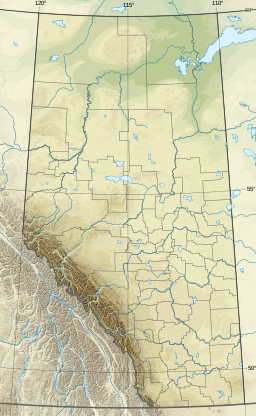| Beaverhill Lake | |
|---|---|
| amisk-wa-chi-sakhahigan (Cree) | |
 Beaverhill Lake from Francis Viewpoint in 2010 | |
| Location | Beaver County / Lamont County, Alberta |
| Coordinates | 53°27′09″N 112°32′08″W / 53.45250°N 112.53556°W |
| Catchment area | 1,970 km2 (760 sq mi)[1] |
| Basin countries | Canada |
| Surface area | 139 km2 (54 sq mi) |
| Max. depth | 2.3 m (7 ft 7 in) |
| Surface elevation | 668 m (2,192 ft) |
| Official name | Beaverhill Lake |
| Designated | May 27, 1987 |
| Reference no. | 370[2] |
Beaverhill Lake (Cree: amisk-wa-chi-sakhahigan) is a large lake in central Alberta, Canada. It is a site of regional importance in the Western Hemisphere Shorebird Reserve Network.[3] It is managed by the Canadian Wildlife Service division of Environment Canada.
It is located 70 km southeast of Edmonton, near the town of Tofield, and lies in the hydrographic basin of the North Saskatchewan River.[4]
As recently as 1990, the lake had a total area of 139 km2 (54 sq mi) and a maximum depth of only 2.3 m (7 ft 7 in)[4] Like similar "prairie pothole" lakes, Beaverhill lake receded significantly after much of its headwaters were diverted, in recent years it has lost about one-quarter of its depth between 1999 and 2009.[5]
The lake is an important bird habitat and has been designated as a "National Nature Viewpoint" by Nature Canada (formerly known as the Canadian Nature Federation) in 1981. The Beaverhill Natural Area was established in 1987 to protect the lake and its surrounding area. Beaverhill Lake Heritage Rangeland Natural Area is also established on what were the shores of the lake.[6]
The Beaverhill Lake Group, a stratigraphical unit of the Western Canadian Sedimentary Basin was named for this lake.
- ^ "Beaverhill Lake". albertalakes.ualberta.ca. University of Alberta Press, 1990. Retrieved April 17, 2020.
- ^ "Beaverhill Lake". Ramsar Sites Information Service. Retrieved 25 April 2018.
- ^ "Beaverhill Lake: Site Description". Manomet Center For Conservation Sciences. Retrieved 2008-02-18.
- ^ a b Mitchell, Patricia; Prepas, Ellie E. (1990). Atlas of Alberta Lakes. University of Alberta Press. ISBN 978-0-88864-214-1. Archived from the original on 2015-02-10.
- ^ Weber, Bob (20 July 2009). "Birds at risk as Prairie lakes dry up". Winnipeg Free Press. Retrieved 12 May 2012.
- ^ Alberta Community Development - Beavehill Natural Area Archived 2004-08-13 at the Wayback Machine, Beaverhill Lake Heritage Rangeland Natural Area[dead link]
